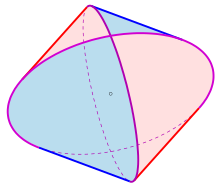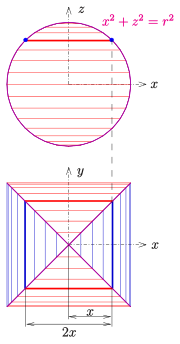Stonemason body
In geometry , a Steinmetz body is a body that is created as the intersection of two or three perpendicular circular cylinders whose axes intersect perpendicularly. They are named after the German-born American electrical engineer Charles Proteus Steinmetz . Steinmetz gave formulas for the volumes of such bodies. However, these were known much earlier. Archimedes and Zu Chongzhi were already able to calculate the volume of the intersection of two full cylinders.
In English literature these bodies are also called bicylinder or tricylinder . In the German-language literature these bodies have no special names.
Steinmetz body made of 2 cylinders
A Steinmetz body as the intersection of two cylinders with a radius has that
- volume
and the
- surface
- .
Proof of the volume formula:
To prove the volume formula, the idea on which the calculation of the volume of a solid of revolution is based can be used. When calculating the volume of a surface of revolution, you simply replace the thin cylindrical disks with thin cuboid disks, the base of which here are squares. This leads to the corresponding volume formula (see sketch)
- .
Comparison with an inscribed pyramid and an inscribed cuboid:
The volumes of a circular cone, a hemisphere and a circular cylinder with the same radii and heights (= radius) are known to be 1: 2: 3. The same remarkable volume ratio applies to the square pyramid ( ) inscribed on half the Steinmetz body , the half Steinmetz Body ( ) and the cuboid ( ) around half the Steinmetz body .
Proof of the surface formula:
The surface consists of 2 red and 2 blue triangles. Now you cut a red triangle in two halves with the help of the yz-plane and unfold one of the halves in such a way that the cutting semicircle starts at the zero point on the positive axis and the development is limited upwards by the half sine curve . The area of this development is then
- .
So the whole surface is
- .
Steinmetz body made of 3 cylinders
The intersection of three perpendicular circular cylinders, the axes of which intersect perpendicularly, results in a body with corners in which 3 intersection curves meet and corners in which 4 intersection curves meet. The totality of the corners can be understood as the corners of a rhombic dodecahedron . The key to calculating volume and surface area is to observe that the body can be put together from the cube with the corners where 3 edges intersect and curved pyramids (the side triangles are made up of cylindrical surface parts) over the side surfaces of this cube. The volume and surface area of such a curved pyramid can be calculated with considerations as in the previous case.
For the volume of the Steinmetz body it finally results
and the surface is
literature
- Tom M. Apostol, Mamikon A. Mnatsakanian: Solids Circumscribing Spheres . In: American Mathematical Monthly . 113, No. 6, 2006, pp. 521-540. doi : 10.2307 / 27641977 .
- Jan Hogendijk : The Surface Area of the Bicylinder and Archimedes' Method . In: Historia Math. . 29, No. 2, 2002, pp. 199-203. doi : 10.1006 / hmat.2002.2349 .
- M. Moore: Symmetrical Intersections of Right Circular Cylinders . In: The Mathematical Gazette . 58, No. 405, 1974, pp. 181-185. doi : 10.2307 / 3615957 .
Web links
- E. Baumann: cylinder sections
- P. Bourke: Intersecting cylinders.
- AJ Hildebrand et al: Intersecting Cylinders: From Archimedes and Zu Chongzhi to Steinmetz and Beyond.
- H. Schumann: The interactive construction of penetrating objects with Cabri 3D. (PDF; 2 MB), pp. 9, 10.
- Eric W. Weisstein : Steinmetz Solid . In: MathWorld (English).
supporting documents
- ^ Howard Eves: Slicing it thin. In: David Klarner: The mathematical Gardner. Wadsworth International, 1981, p. 111.
- ↑ Intersecting Cylinders: From Archimedes and Zu Chongzhi to Steinmetz and Beyond
















